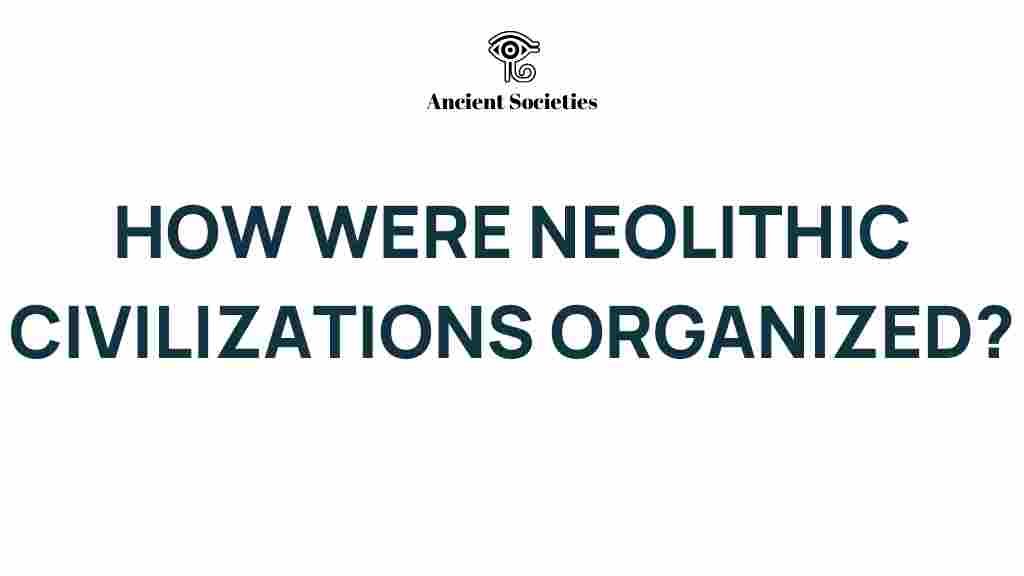Unraveling the Secrets of Neolithic Civilization Organization
The Neolithic period, often referred to as the New Stone Age, marks a turning point in human history where societies transitioned from nomadic lifestyles to settled communities. This transformation laid the groundwork for civilization as we know it today. In this article, we will delve into the organization of Neolithic civilizations, exploring their societal structures, cultural practices, agricultural innovations, and settlement patterns. Understanding these aspects of Neolithic life is essential for appreciating the foundations of modern society.
The Rise of Neolithic Societies
During the Neolithic era, which began around 10,000 BCE, humans began to domesticate plants and animals, leading to a significant shift in their way of life. This period is characterized by:
- Agricultural advancements: The cultivation of crops such as wheat, barley, and legumes.
- Animal husbandry: The domestication of animals like sheep, goats, and cattle.
- Settlement patterns: The establishment of permanent villages and towns.
The organization of these early societies was complex and varied across different regions. Archaeological evidence reveals much about their structure, culture, and interactions.
Archaeology and the Study of Neolithic Civilization
Archaeology plays a crucial role in uncovering the secrets of Neolithic civilization organization. Excavations at various Neolithic sites have provided invaluable insight into:
- Settlement layouts: The arrangement of houses, communal spaces, and agricultural fields.
- Material culture: Tools, pottery, and artifacts that reflect daily life.
- Social hierarchy: Evidence of leadership roles and community organization.
For instance, sites like Çatalhöyük in modern-day Turkey and Jericho in the Middle East showcase the complexity of Neolithic settlements. These archaeological findings reveal a rich tapestry of life that was both communal and organized.
Community Structures in Neolithic Life
The organization of Neolithic communities was characterized by several key features:
- Clan and family units: Families often lived together in extended kinship groups, sharing resources and responsibilities.
- Leadership roles: Some communities had leaders or elders who made decisions for the group, often based on consensus.
- Specialization of labor: As agriculture flourished, not all members were needed for farming. Some became artisans, toolmakers, or traders.
This specialization contributed to the development of culture and society, as individuals began to focus on different skills and trades, fostering innovation and creativity.
Cultural Practices and Beliefs
The cultural practices of Neolithic societies were diverse, reflecting their beliefs, traditions, and interactions with the environment. Important aspects included:
- Religious beliefs: Many Neolithic communities engaged in rituals and worship, often centered around fertility and nature.
- Artistic expression: Cave paintings, pottery, and sculptures were common, showcasing the creativity of these ancient people.
- Festivals and gatherings: Community events likely played a role in strengthening social bonds and sharing resources.
These cultural elements were not only vital for cohesion within communities but also for the transmission of knowledge and traditions across generations.
Agriculture: The Backbone of Neolithic Civilization
Agriculture was the cornerstone of Neolithic civilization organization. The transition from foraging to farming allowed communities to settle in one place, leading to:
- Increased food production: A stable food supply supported larger populations.
- Trade networks: Surpluses led to the exchange of goods, fostering trade and interaction between communities.
- Technological advancements: Innovations such as irrigation, plowing, and storage techniques emerged from agricultural practices.
These developments were crucial for the growth of Neolithic societies, enabling them to thrive and expand.
Settlement Patterns and Community Design
The design and layout of Neolithic settlements were instrumental in their organization. Key features included:
- Centralized communal spaces: Areas for gatherings, rituals, and social interactions.
- Residential structures: Houses built from mud, stone, or timber, often arranged in clusters.
- Defensive features: Some settlements included walls or barriers for protection against threats.
Understanding these patterns helps archaeologists reconstruct the daily lives of Neolithic people and their interactions within their communities.
Challenges in Neolithic Civilization Organization
Despite the advancements, Neolithic societies faced various challenges that influenced their organization:
- Resource scarcity: As populations grew, the demand for resources increased, leading to potential conflicts.
- Environmental changes: Climate shifts could affect agricultural productivity, prompting migration or adaptation.
- Social tensions: As communities became more complex, issues related to leadership, resource distribution, and social inequality may have arisen.
These challenges shaped the evolution of Neolithic civilizations, leading to innovations in organization and governance.
Archaeological Discoveries and Their Significance
Recent archaeological discoveries continue to shed light on the organization of Neolithic civilizations. For example, the findings at Çatalhöyük reveal complex social structures and cultural practices that highlight the sophistication of these ancient communities. The significance of these discoveries includes:
- Understanding social dynamics: Insights into how communities formed and functioned.
- Revealing technological advancements: Innovations that arose from the need to support growing populations.
- Documenting cultural diversity: Evidence of varied practices and beliefs across different regions.
These findings enhance our understanding of human history and the development of civilization.
Conclusion: The Legacy of Neolithic Civilization Organization
The organization of Neolithic civilizations was a complex interplay of agriculture, community dynamics, cultural practices, and social structures. As we unravel the secrets of this era through archaeology, we gain valuable insights into the foundations of modern society. The lessons learned from Neolithic organizations continue to resonate today, reminding us of the importance of community, innovation, and adaptability.
In exploring the Neolithic period, we not only uncover the past but also reflect on the enduring human spirit that has shaped our cultures and societies throughout history.
This article is in the category Archaeology and created by AncientSocieties Team

1 thought on “Unraveling the Secrets of Neolithic Civilization Organization”